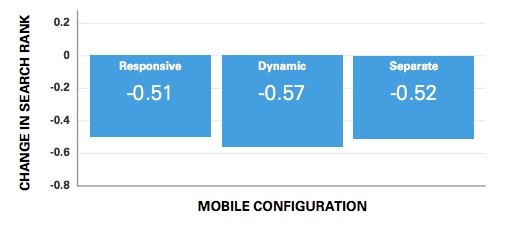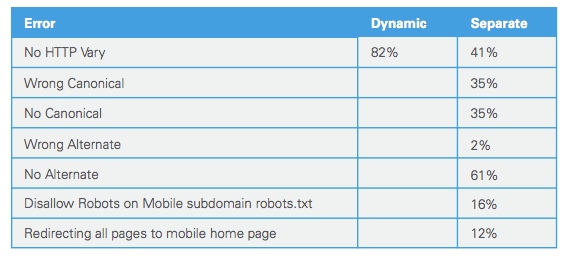Even if you’ve decided to “go mobile,” you may be losing an average of 68 percent of smartphone traffic. Why? This is a result of incorrectly implemented mobile solutions, BrightEdge says, and new data coming from the company shows that 27 percent of sites studied have some sort of errors with mobile implementation.
BrightEdge’s Mobile Share Report looks at the various types of mobile solutions – responsive design, dynamic serving, and separate mobile URLs – to see which configuration has the most errors associated with it, and how that affects important outcomes like rankings and traffic.
When it comes to type of mobile solution, Google has indicated it supports all three of the aforementioned types. But since responsive has been dubbed the solution of choice by Google, BrightEdge wanted to find out if sites that implemented responsive design over other types of mobile solutions like separate mobile URLs or dynamic serving had a better chance of ranking.
Good news for mobile sites: BrightEdge research showed there was not a significant difference between smartphone rankings based on mobile configuration.

“Data from BrightEdge’s Data Cube shows that for a given keyword, on average, a website’s rank for smartphone users varies only slightly based on the type of mobile configuration a website has implemented,” the report said. “So, for example, if a site is ranked No. 3 on a desktop, it would rank 3.5 (on average) on a smartphone device. This data represents the average across billions of keywords studied.”
Any difference in rank is likely due the local search results pushing other results down on the SERP, said the report.
However, when it comes to implementation errors, the results are in: responsive design has the propensity for much less error over configurations like separate mobile URLs.
In fact, of the sites studied, 72 percent of separate mobile URLs had errors, versus a negligible amount for responsive design. Dynamic serving experienced a 30-percent error rate.
Some of the most common errors are highlighted in the following chart:

“For separate mobile URLs, there are a handful of common mistakes made in implementation,” the report said. “BrightEdge research showed that no HTTP Vary header was a common mistake amongst two approaches: dynamic serving (82 percent) and separate mobile URLs (41 percent). And among the separate mobile URL approaches, not having an alternate URL tag was the most common error 61 percent of the time.”
These errors result in a poor experience for users, and Google has said that sites that don’t provide a good mobile experience may not be able to compete as well in the search results.
BrightEdge’s research supports that notion, showing sites with incorrectly implemented mobile solutions saw an average smartphone rank drop by about 1.82 positions.
On average, 62 percent of organic searches now show different results depending on whether the search was performed on a desktop or smartphone, according to BrightEdge data.
That means, the search results are dramatically changing to cater to devices, and sites that don’t keep up, said BrightEdge, will lose out on huge ranking and traffic opportunity.
“If you think about it, a couple years ago, there wasn’t a lot of difference between if you searched on desktop versus mobile in terms of the rankings between smartphone and desktop,” said Jim Yu, BrightEdge founder and CEO.
Then for a period of time, said Yu, the results became location-sensitive by device, and now, a huge percentage varies from desktop to smartphone. “This change really means that as marketers and brands, we need to pay attention to how we’re approaching mobile,” he said.
In its report, BrightEdge outlines ways to choose the type of mobile configuration, and things to watch for during implementation. Yu said brands need specialized expertise when implementing mobile.
Especially with the latest trend in mobile, where brands are taking a hybrid approach. Some brands are moving their sites to responsive, for example, but layering other type of mobile configurations on top such as dynamic serving, Yu said.
This hybrid approach is something brands may choose to create a unique experience for their most important landing pages where they are trying to drive conversions.
This innovative approach may be great for user experience and conversions, but implementation errors could go up, said Yu. “It’s harder to maintain,” he said.
For all of those reasons and more, brands need qualified skills sets on a team when implementing mobile. As an SEO or marketing team, “one of the key things is that you are going to have to work very closely with the IT and development teams,” Yu said.
And mobile implementation is not just a set-it-and-forget-it initiative, he added. “Even when people implement it right the first time, they don’t keep it correctly implemented when, for example, lots of different people are touching the site.”
For more information on the mobile research coming from BrightEdge, including tips on how to choose and implement a mobile solution, the full report can be accessed here.

